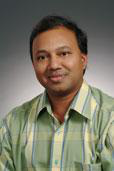报告题目: Center for Compressible Multiphase Turbulence and An Improved Point-Particle Approach that Captures Fully-Resolved Physics
报告人: Prof. S. Balachandar
报告人单位:Department of Mechanical and Aerospace Engineering, University of Florida
报告时间:June 12 (Tuesday) 3:00pm-5:00pm
报告地点:B-518, Lee Shau Kee Building of Science and Technology
邀请人: Prof. Chao Sun
Abstract
The first 15 minutes of the talk with provide a overview of the department of energy center of excellence in exascale predictive simulation activities. The remain 30+ minutes will cover an in-depth look at multiphase modeling and simulation activities of the center.
Euler-Lagrange point-particle (EL-PP) technique has been increasingly employed for solving particle, droplet and bubble-laden flows. Since flow around the individual particles is not resolved, the accuracy of the technique depends on the fidelity of the force law used for representing the fluid-particle momentum exchange that occurs at the microscale. In the first part of the talk we will discuss the generalized Faxen form of the force law, which allows accurate accounting of the coupling between the flow and the particle even under complex conditions, where the length and time scales of the flow are comparable to those of the particle (such as during shock-particle interaction).
The applicability of the above approach is however still limited to particles of size much smaller than the grid scale and to dilute flows where inter-particle interaction is weak. In the second part of the talk we will discuss recent fundamental developments that begin to ease these limitations. With increasing numerical resolution, as the grid size approaches the particle size, we face the unpleasant prospect of force law becoming less accurate. This is due to the self-induced flow generated at the particle location, which corrupts the estimation of undisturbed flow velocity that is needed in the force evaluation. We will discuss theoretical approached to properly correcting for the self-induced flow. Finally, we will present the pairwise interaction extended point-particle (PIEP) model which rigorously extends the point-particle technique to higher volume fractions. This model systematically accounts for the precise location of all the neighboring particles in computing the hydrodynamic force on each particle. The model assumes pairwise interaction so that the perturbation flow induced by each neighbor can be considered separately and superposed. The generalized Faxén form is then used to quantify the perturbation force due to the presence of the neighbors. The PIEP model predictions are compared against corresponding DNS in a number of test problems.
Bio:

S."Bala" Balachandar got his undergraduate degree in Mechanical Engineering at the Indian Institute of Technology, Madras in 1983 and his MS and PhD in Applied Mathematics and Engineering at Brown University in 1985 and 1989. From 1990 to 2005 he was at the University of Illinois, Urbana-Champaign, in the Department of Theoretical and Applied Mechanics. From 2005 to 2011 he served as the Chairman of the Department of Mechanical and Aerospace Engineering at the University of Florida. Currently he is a distinguished professor at the University of Florida. He is the William F. Powers Professor of Mechanical & Aerospace Engineering and the Director of College of Engineering Institute for Computational Engineering. Bala received the Francois Naftali Frenkiel Award from American Physical Society (APS) Division of Fluid Dynamics (DFD) in 1996 and the Arnold O. Beckman Award and the University Scholar Award from University of Illinois. He is Fellow of ASME and the American Physical Society Division of Fluid Dynamics. He was the recipient of ASME Freeman Fellow in 2017. He is currently the editor-in-chief of the International Journal of Multiphase Flow and a handling editor of the Theoretical and Computational Fluid Dynamics.